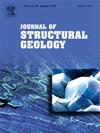Sequence, duration, rate of deformation and paleostress evolution during fold development: Insights from fractures, calcite twins and U-Pb calcite geochronology in the Mirabeau anticline (SE France)
IF 2.9
2区 地球科学
Q2 GEOSCIENCES, MULTIDISCIPLINARY
引用次数: 0
Abstract
The timing and duration of folding events have traditionally been constrained by the dating of syn-tectonic layers that record fold growth and limb rotation. However, recent advances demonstrate that absolute U-Pb geochronology on well-characterized distributed mesoscale structures such as fractures and stylolites allows the reconstruction of a detailed deformation timeline spanning the entire folding event even when growth strata are absent. In this study, we integrate structural analysis with calcite twin paleopiezometry, inversion of fault slip data, and U-Pb dating of syn-tectonic calcite mineralizations from faults, veins and stylolite-related jogs to refine the classical fold-fracture model and provide a more comprehensive view and precise timing of brittle deformation and stress evolution during folding using the example of the Mirabeau anticline (Provence, SE France). The onset of layer-parallel shortening (LPS) has been precisely constrained for the first time using absolute U-Pb dating of a calcite-filled jog associated with a bedding-parallel stylolite (BPS) and the earliest striated reverse faults associated with Pyrenean shortening. The brittle deformation associated with the folding event of the Mirabeau anticline is recorded continuously between ∼50 Ma and ∼37 Ma, with layer parallel shortening (LPS) lasting ∼5 My, fold growth lasting ∼3 My, and late-stage fold tightening (LSFT) lasting ∼5 My. Combining our shortening estimate derived from and balanced cross-section with absolute ages of fold growth, we estimate a Pyrenean shortening rate of approximately 0.6 mm/yr at Mirabeau. Our results further place important new time constraints on the sequence of structural development through the Provence fold-and-thrust belt, and support a forelandward propagation of Pyrenean deformation across Provence.
The integration of fracture sequence analysis, calcite twin inversion and striated fault inversion provides insights into the tectonic evolution of the Mirabeau area: (1) pre-Pyrenean alternating NNE-SSW and WNW-ESE extension between ∼112 and ∼90 Ma, likely related to the Durance uplift event (2) Eocene Pyrenean-Provençal shortening dominated by a N-S to NE-SW horizontal σ1 under alternating compressional and strike-slip stress regimes, (3) Oligocene E-W extension associated with the West European rifting event, and (4) a minor compressional stress regime with NW-SE to NNW-SSE oriented σ1 attributed to Miocene Alpine shortening.
褶皱发育的层序、持续时间、变形速率和古应力演化:来自米拉波背斜裂缝、方解石孪晶和U-Pb方解石年代学的启示
传统上,褶皱事件的时间和持续时间受到记录褶皱生长和分支旋转的同构造层定年的限制。然而,最近的进展表明,即使在没有生长层的情况下,在具有良好特征的分布中尺度构造(如裂缝和柱面岩)上的绝对U-Pb年代学也可以重建整个褶皱事件的详细变形时间。在这项研究中,我们将构造分析与方解石双古构造测量、断层滑动数据反演以及同构造方解石矿化的U-Pb测年相结合,以断层、脉和柱面岩相关的斜坡为例,完善了经典的褶皱断裂模型,并提供了褶皱脆性变形和应力演化的更全面的观点和精确的时间。利用与层状平行柱体(BPS)相关的方解石充填断层和与比利牛斯山缩短相关的最早的条纹状逆断层的绝对U-Pb定年,首次精确地限制了层状平行缩短(LPS)的发生。与Mirabeau背斜褶皱事件相关的脆性变形在~ 50 Ma至~ 37 Ma之间连续记录,其中层平行缩短(LPS)持续~ 5 Ma,褶皱生长持续~ 3 Ma,后期褶皱紧缩(LSFT)持续~ 5 Ma。结合我们从平衡剖面得到的缩短估计和褶皱生长的绝对年龄,我们估计在Mirabeau的比利牛斯山缩短率约为0.6 mm/年。我们的研究结果进一步对通过普罗旺斯褶皱冲断带的构造发育序列提出了重要的新时间限制,并支持比利牛斯山脉变形在普罗旺斯的前向传播。裂缝层序分析、方解石双生体反演和条纹断裂反演相结合,为研究Mirabeau地区构造演化提供了新的思路。(1)在~ 112 ~ ~ 90 Ma之间,前billy牛斯期NNE-SSW和WNW-ESE交替伸展,可能与Durance隆升事件有关;(2)始新世billy牛斯- provenalal在挤压和走滑交替应力作用下,以N-S至NE-SW水平σ1为主的缩短;(3)渐新世E-W伸展与西欧裂陷事件有关;(4)中新世阿尔卑斯缩短作用为NW-SE至NNW-SSE方向的小挤压应力作用。
本文章由计算机程序翻译,如有差异,请以英文原文为准。
求助全文
约1分钟内获得全文
求助全文
来源期刊

Journal of Structural Geology
地学-地球科学综合
CiteScore
6.00
自引率
19.40%
发文量
192
审稿时长
15.7 weeks
期刊介绍:
The Journal of Structural Geology publishes process-oriented investigations about structural geology using appropriate combinations of analog and digital field data, seismic reflection data, satellite-derived data, geometric analysis, kinematic analysis, laboratory experiments, computer visualizations, and analogue or numerical modelling on all scales. Contributions are encouraged to draw perspectives from rheology, rock mechanics, geophysics,metamorphism, sedimentology, petroleum geology, economic geology, geodynamics, planetary geology, tectonics and neotectonics to provide a more powerful understanding of deformation processes and systems. Given the visual nature of the discipline, supplementary materials that portray the data and analysis in 3-D or quasi 3-D manners, including the use of videos, and/or graphical abstracts can significantly strengthen the impact of contributions.
 求助内容:
求助内容: 应助结果提醒方式:
应助结果提醒方式:


